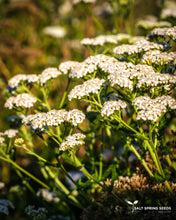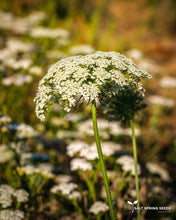Yarrow is very commonly found in open sites and in gardens and is one of the most widely used medicinal plants in the world.
It is an aromatic perennial herb with white (sometimes pink) flower heads and usually grows a few feet high. Yarrow plants are hardy, attractive and pleasant to have in the garden, though their creeping rhizomes can sometimes spread considerably. The small abundant flowers have a spicy scent and bloom from June to September. They are lovely in fresh or dried flower arrangements. The leaves are finely divided and look like large fuzzy pipe cleaners.
The genus name Achillea comes from the Greek hero who reputedly saved the lives of many of his soldiers by applying Yarrow to their wounds. Yarrow plants contain alkaloids that have been shown to reduce clotting time and that have been used to suppress menstruation and menstrual cramps.
Around the world, yarrow leaves have been commonly used in washes, salves and poultices for treating burns, boils, open sores, pimples, mosquito bites, ear aches, sore eyes and aching muscles. Yarrow tea has been known as a tonic for colds and fevers because it stimulates sweating and lowers blood pressure. Herbalists classify Yarrow as sedative, antiseptic, anti-inflammatory and anti-spasmodic.
Yarrow leaves are sometimes chewed to ease aching teeth. Yarrow tea makes an excellent hair rinse.
When yarrow goes to seed in late summer, it is easy to rub the seeds into a container. If you do so, you’ll find that yarrow hosts an amazing amount of small insects. Give these bugs a chance to flee for a few days before putting the seeds into a container. In spring, sow the seeds in potting soil and let them size up for about eight weeks if you want to establish a Yarrow patch. You can also propagate Yarrow by dividing the roots in spring or fall. It requires little care, is very drought-resistant and prefers full sun.
Yarrow is a significant healing plant that is unlikely to ever be on an endangered list.




